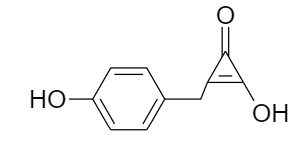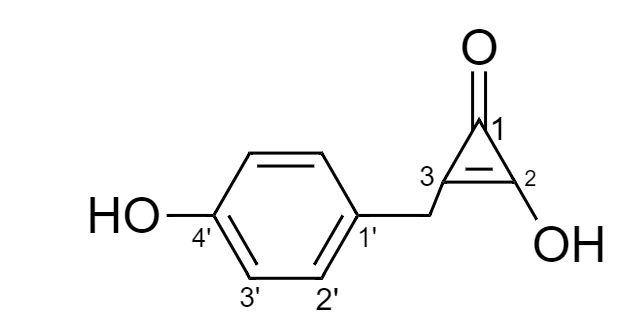
The IUPAC name of the compound given below is:

(A) $ \text{2}-\text{Hydroxy}-\text{3}\left( \text{4 }\!\!'\!\!\text{ }-\text{hydroxyphenyl} \right)\text{cycloprop}-\text{2}-\text{en}-\text{1}-\text{one} $
(B) $ \text{2}-\text{Hydroxy}-\text{3}\left( \text{4 }\!\!'\!\!\text{ }-\text{hydroxyphenylmethyl} \right)\text{cycloprop}-\text{2}-\text{en}-\text{1}-\text{one} $
(C) $ \text{4}-(\text{2 }\!\!'\!\!\text{ }-\text{Hydroxy}-\text{3 }\!\!'\!\!\text{ }-\text{oxocycloprop}-1'-\text{enylmethyl)phenol} $
(D) $ \text{4}-(1\text{ }\!\!'\!\!\text{ }-\text{Hydroxy}-\text{3 }\!\!'\!\!\text{ }-\text{oxocycloprop}-1'-\text{enylmethyl)phenol} $

Answer
502.2k+ views
Hint : In organic chemistry, IUPAC nomenclature is a method of naming organic compounds according to standards set by the international union of pure and applied chemistry. But due to its long and tedious names, generally common names are more preferred over IUPAC names.
Complete Step By Step Answer:
As the given compound is an aromatic compound consisting of a benzene ring. So, rules for naming an organic compound according to IUPAC nomenclature are as follows:
For substituted benzene rings having more than six carbon atoms, the benzene ring is denoted by the word phenyl as the prefix of the alkane present which means for the given case, the base of the IUPAC name will consist of the cycloalkane part.
Ketone group has higher preference than that of hydroxyl group i.e., the IUPAC name will end with suffix -one rather than the suffix -ol.
The position of double bond and the substituent groups in the ring are located in such a way that the minimum possible number is assigned to the groups according to the priority order.
Therefore, for the given compound the numbering is done as follows:

Hence, IUPAC name for the given compound is as follows:
$ \text{2}-\text{Hydroxy}-\text{3}\left( \text{4 }\!\!'\!\!\text{ }-\text{hydroxyphenylmethyl} \right)\text{cycloprop}-\text{2}-\text{en}-\text{1}-\text{one} $
Thus, option (B) is the correct answer.
Note :
It is important to note that the cyclopropane ring is not directly connected to the benzene ring but is connected via methyl group that is why methyl word is also used in the naming of substituent at third carbon. Also, due to the presence of a cyclic group as a substituent on benzene ring, the ring will not have a root or base name as phenol.
Complete Step By Step Answer:
As the given compound is an aromatic compound consisting of a benzene ring. So, rules for naming an organic compound according to IUPAC nomenclature are as follows:
For substituted benzene rings having more than six carbon atoms, the benzene ring is denoted by the word phenyl as the prefix of the alkane present which means for the given case, the base of the IUPAC name will consist of the cycloalkane part.
Ketone group has higher preference than that of hydroxyl group i.e., the IUPAC name will end with suffix -one rather than the suffix -ol.
The position of double bond and the substituent groups in the ring are located in such a way that the minimum possible number is assigned to the groups according to the priority order.
Therefore, for the given compound the numbering is done as follows:

Hence, IUPAC name for the given compound is as follows:
$ \text{2}-\text{Hydroxy}-\text{3}\left( \text{4 }\!\!'\!\!\text{ }-\text{hydroxyphenylmethyl} \right)\text{cycloprop}-\text{2}-\text{en}-\text{1}-\text{one} $
Thus, option (B) is the correct answer.
Note :
It is important to note that the cyclopropane ring is not directly connected to the benzene ring but is connected via methyl group that is why methyl word is also used in the naming of substituent at third carbon. Also, due to the presence of a cyclic group as a substituent on benzene ring, the ring will not have a root or base name as phenol.
Recently Updated Pages
Master Class 12 Business Studies: Engaging Questions & Answers for Success

Master Class 12 Economics: Engaging Questions & Answers for Success

Master Class 12 English: Engaging Questions & Answers for Success

Master Class 12 Maths: Engaging Questions & Answers for Success

Master Class 12 Social Science: Engaging Questions & Answers for Success

Master Class 12 Chemistry: Engaging Questions & Answers for Success

Trending doubts
What is meant by exothermic and endothermic reactions class 11 chemistry CBSE

Which animal has three hearts class 11 biology CBSE

10 examples of friction in our daily life

One Metric ton is equal to kg A 10000 B 1000 C 100 class 11 physics CBSE

1 Quintal is equal to a 110 kg b 10 kg c 100kg d 1000 class 11 physics CBSE

Difference Between Prokaryotic Cells and Eukaryotic Cells




